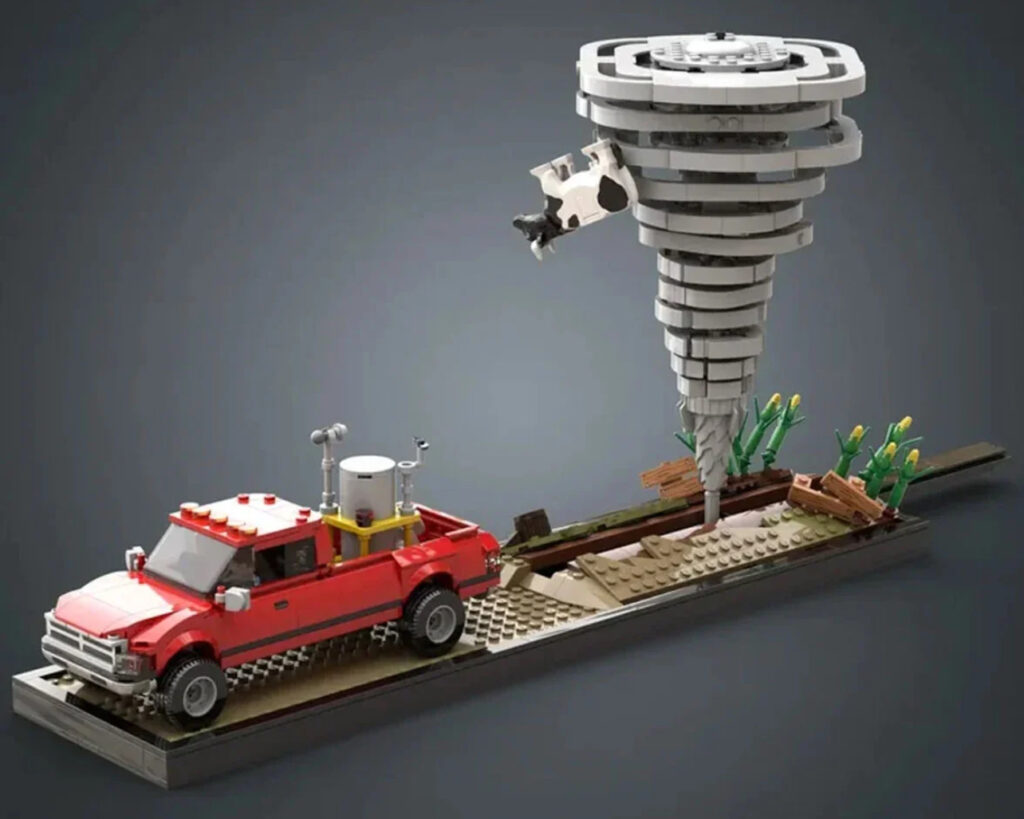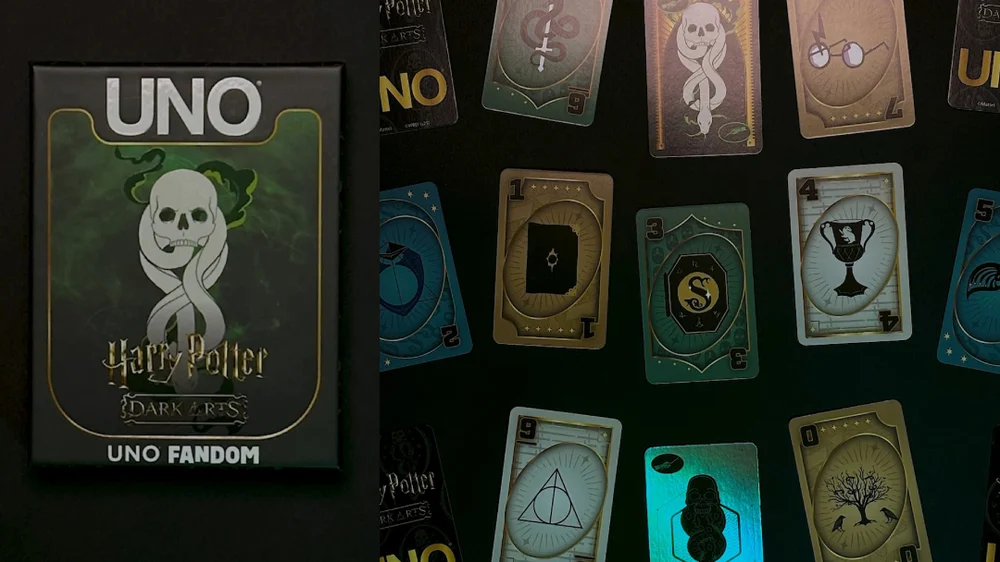When Twister barreled into theaters in 1996, it wasn’t just the gusts of CGI tornadoes or the cow caught in mid-air that made it unforgettable. It was a cinematic tempest that fused adrenaline-pumping action with a reverent fascination for meteorological science. Directed by Jan de Bont and penned by Michael Crichton and Anne-Marie Martin, Twister followed storm chasers Jo and Bill Harding through the heart of Tornado Alley. Their pursuit of nature’s fury wasn’t just spectacle—it was fueled by purpose, captured through an experimental weather probe named “Dorothy.”
Now, nearly three decades later, Twister’s whirlwind legacy has been reinterpreted through an unexpected but perfectly fitting medium: LEGO. Fan designer ComicMischief’s Twister Diorama, submitted via the LEGO Ideas platform, transforms the roaring chaos of the film into an intricate, interactive brick-built experience. It is both homage and reinvention—where plastic bricks meet pop culture lore in a stunning synthesis of memory, imagination, and design precision.
The Cinematic DNA of Twister
At its core, Twister is a story of obsession, science, and redemption, veiled in the thrills of flying debris and thunderous funnel clouds. Released during a golden age of ’90s disaster blockbusters—alongside Independence Day, Dante’s Peak, and Armageddon—Twister distinguished itself by rooting the spectacle in plausible science. The “Dorothy” probe, based on real-world meteorological instruments like TOTO (Totable Tornado Observatory), lent the narrative a factual edge.
Its characters weren’t just victims of disaster but willing participants in nature’s fury. Jo Harding, played by Helen Hunt, was driven by the loss of her father in a tornado, while Bill Paxton’s Bill Harding brought gravitas to a genre often caricatured. But what truly elevated Twister was its visual bravado—the chaotic ballet of barn debris, thunderclouds, and that now-iconic shot of a cow suspended mid-twister like a windborne punctuation mark.
This visual memory is what ComicMischief’s LEGO Diorama so cleverly taps into. It doesn’t just recall Twister—it reconstructs its very ethos.
From Funnel to Figurine: The LEGO Diorama as Narrative Object
Hosted on the collaborative LEGO Ideas platform, ComicMischief’s Twister Diorama emerges not merely as a tribute, but as a compelling act of reinterpretation. LEGO Ideas is no stranger to pop culture builds—fans have successfully brought to life scenes from Seinfeld, Friends, and Stranger Things. Yet what distinguishes this diorama is its ability to translate chaos into structure without losing the source material’s kinetic soul.
The set features a rural landscape with a dilapidated farmhouse, cornfields strewn with debris, a flipped pickup truck, and the looming centerpiece: a brick-built tornado. Twisting upward in a spiral of transparent and grey-toned bricks, the tornado is simultaneously elegant and terrifying. It’s not just a visual center, but a mechanical one too—ComicMischief has included features like rotating debris and movable figures to simulate the motion of a storm caught in motion.
Of course, the cow is present—this time dangling delightfully on a clear stand, forever mid-whirl. The “Dorothy” device is also carefully modeled, with removable canisters and sensor details that nod back to its cinematic counterpart. These touches are more than decorative—they’re reverent.
The Aesthetic of Disaster in Miniature
What makes the Twister Diorama particularly compelling is the paradox it embodies. It turns chaos into diorama. Turbulence becomes tidiness. What was once a cacophony of wind, metal, and splintered wood is now a static—but deeply expressive—object.
LEGO, as a medium, naturally lends itself to nostalgia. Its modularity and tactility give form to memory. But ComicMischief’s project goes beyond mere nostalgia. It reconstructs a moment of cinematic awe into something tactile and collectible, reimagining a visceral event through orderly creativity. The swirling violence of a tornado—once a million-dollar CGI effect—becomes a delicate corkscrew of carefully stacked plates and transparent studs.
This translation is not reductive. It’s transformative.
Fandom as Preservation and Evolution
The brilliance of platforms like LEGO Ideas is how they allow fans to re-author beloved stories. While Hollywood often revisits intellectual property through reboots or sequels, fan designers like ComicMischief offer reinterpretations that respect the original while enriching its meaning.
This kind of LEGO creation isn’t just a physical object. It’s an act of curation and storytelling. It preserves Twister’s legacy not by duplicating the movie, but by distilling its most essential imagery and themes into a new language.
The inclusion of detailed mini-figures modeled after Jo and Bill Harding, complete with meteorological equipment and printed facial expressions, serves as more than a nod to the past—it is an assertion that these characters still matter. That their story, born in 1996, can still speak to new generations through different mediums.
Why Twister Still Matters
In the age of climate anxiety and increasingly volatile weather systems, Twister has found new resonance. What once felt like an edge-of-your-seat thrill now carries undertones of environmental commentary. Tornadoes are no longer anomalies; they’re becoming unnervingly frequent. The film’s blend of science and spectacle, once considered genre flair, now reads as eerily prescient.
LEGO, often considered the domain of youth and whimsy, becomes here a medium of cultural archiving. ComicMischief’s diorama, though playful on the surface, holds deeper value—it preserves a pop culture artifact and allows us to confront disaster in miniature, manageable form.
That act—of shrinking the sublime and terrifying into the palm of a hand—has always been part of humanity’s artistic impulse.
Flow
With his LEGO Twister Diorama, ComicMischief achieves what few fan creations do: he doesn’t just replicate—he reimagines. The build becomes a microcosm not only of the movie’s storm-chasing thrills, but of the emotional current that underpinned them: the longing to understand the uncontrollable, to chase answers through the maelstrom.
It is a tribute to film, yes. But it is also a tribute to fans, to builders, to those who still find joy in rebuilding scenes they love—not for clout, but for connection.
And in a world where the storms feel increasingly real, perhaps a brick-built tornado is exactly the kind of controlled chaos we need.
No comments yet.









